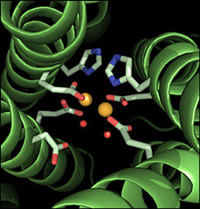Potential new target for drugs to treat iron deficiency and overload discovered
Advertisement
The discovery of a major player in the body's regulation of iron levels should provide a new target for drugs that prevent common iron deficiency as well as rare, potentially deadly iron overload, researchers said. Medical College of Georgia researchers noted in "Blood" that the protein neogenin, a receptor that AIDS in neural development, is also part of the body's interwoven regulatory process for iron. The receptor, located on the cell surface, should be an easy target for drug development to help increase or decrease iron levels as needed, said Dr. Wen-Cheng Xiong, the study's corresponding author and a developmental neurobiologist at the Medical College of Georgia Schools of medicine and Graduate Studies.
Iron, an essential nutrient in foods such as meats, beans and spinach, is used by all cells but primarily helps red blood cells deliver oxygen throughout the body. However, in some individuals, low levels cause iron deficiency-anemia while genetic diseases such as juvenile hemochromatosis or blood transfusions can result in toxic levels of iron in the body.
In the brain, neogenin works with other molecules to heard neurons in the right direction. One of those molecules, repulsive guidance molecules, or RGMs, are already known to help regulate iron levels, which led MCG researchers to suspect neogenin had a role as well.
Studies in mice showed neogenin inhibits secretion of an RGM gene called hemojuvelin. That reduces the signaling of a protein that reduces expression of hepcidin, a hormone released by the liver to control circulating iron levels by storing it in the spleen until it is needed and directing the intestines on how much iron to absorb or eliminate. In cells in culture, researchers consistently found that increased expression of hemojuvelin increases hepcidin expression while suppression decreases it.
Next steps include determining whether neogenin expression is up or down in patients with iron-related issues such as anemia or juvenile hemochromatosis.























































